
Worms that infect human internal organs are called helminths (worms). According to statistics, today about 30% of the total population is prone to helminthic invasion. Worms that poison the body can infect any part of the body. This is not only dangerous for diseases that can provoke helminths. Their presence in the body can be fatal.
To this day, helminthiasis can be completely cured not only with drugs but also with folk remedies. Each type has its own methods of treatment. Therefore, it is worth knowing and understanding in time what the types of worms are and the symptoms of the parasitic infection.
Classification of helminthiasis
Parasitic worms can be divided into two major groups: gut and tissue.
The first species lives directly in the intestines. This group includes:
- globular worms and pinworms;
- hookworms and lamblia;
- whipworms and dwarf tapeworms;
- bovine tapeworm and broad tapeworm;
- pig tapeworm.
Tissue worms can live in any organ of the human body and parasitize for many years. These include:
- cysticercus and trematodes;
- trichinella and liver layer;
- echinococcus and alveococcus.
Roundworm
These are the most common and complex worms that live in the small intestine of an adult or child. Infection with this type of helminth is called ascariasis.
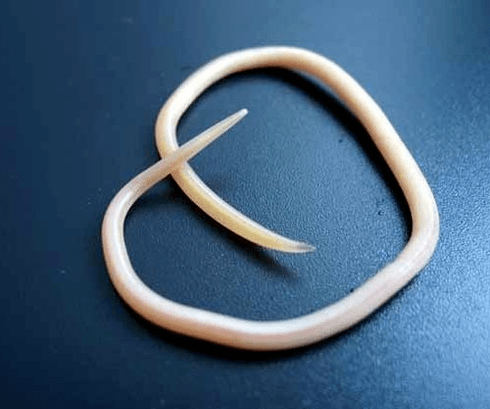
In the first days of invasion, one begins to feel malaise, nervousness, fever, shortness of breath, cough, and pain in the chest area. Such symptoms are justified by the fact that helminths initially affect the respiratory system.
Infection can occur by consuming raw water from uncontrolled sources, poorly processed fresh fruits and vegetables. In summer, the risk of ascariasis increases.
Pinworms
Small helminths that settle in the intestines cause a disease called enterobiasis. The worms lay their eggs in the anal area. The eggs turn into larvae and can only re-enter the body through the oral cavity.
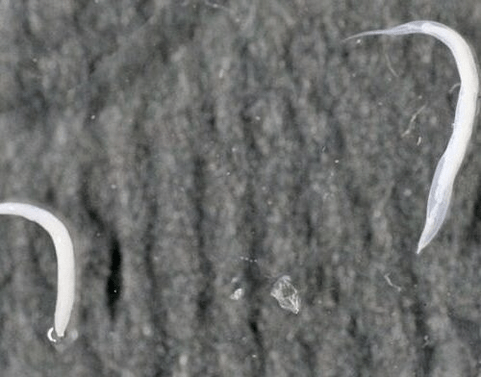
Re-infection results from contact of the person with enterobiasis with dirty hands with the food consumed. Symptoms of infection may include itching around the rectum and increased irritability.
Important! The disease is carried by humans.
Hookworm
Hookworm infection occurs through skin in contact with the soil, where the larvae of these types of worms live.
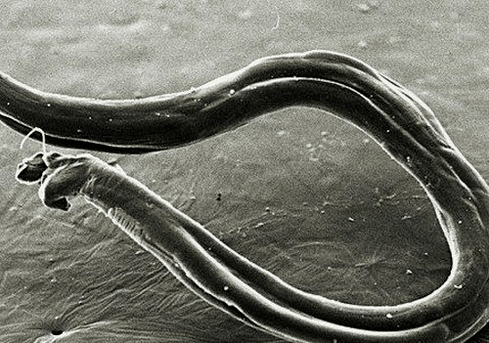
Hookworms follow the same path as roundworms before entering the intestines.
Symptoms include cough, lower abdominal pain, nausea, and stool disturbances. This type of helminthiasis can cause anemia.
Giardia
Giardiasis develops in people who have a habit of biting nails and other objects (pencils, pens). Infection can also occur with poor quality water, drinking unwashed products, contact with dirty clothes where there may be larvae, and the carrier of the disease.
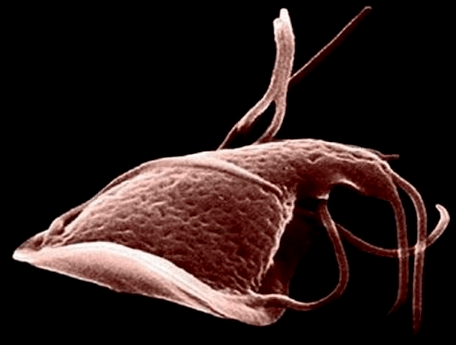
Symptoms of infection may include loose stools and lower abdominal pain.
Vlasoglava
Trichocephalosis occurs during infection with whipworm larvae. They are included with unprocessed fruits and vegetables. Dirty hands and water are vector.
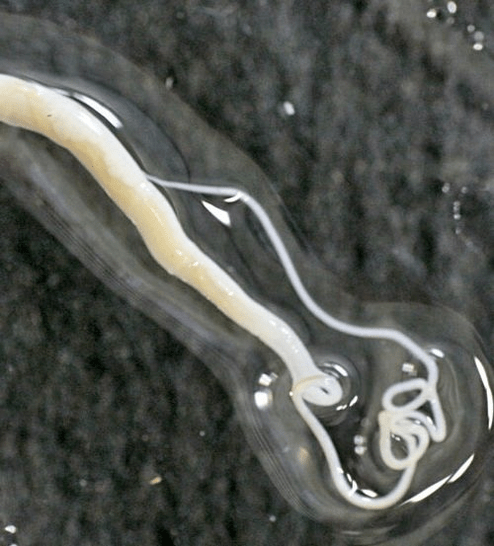
The invasion is accompanied by acute abdominal pain, diarrhea and decreased appetite. Signs of infection are often similar to appendicitis.
Dwarf tapeworm
Worm infestation is not only done with dirty hands and unwashed food, but can also be carried by insects.
The dwarf tapeworm affects the intestines and liver, causing inflammation and poisoning.
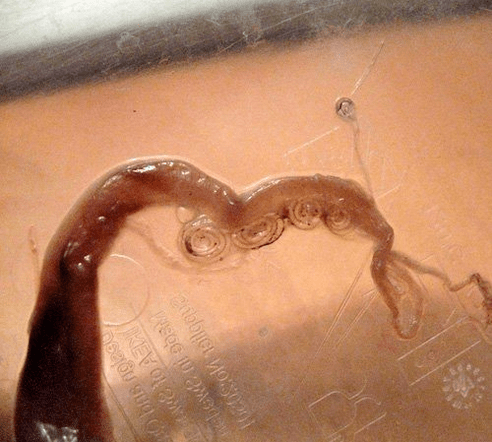
Himenolepiasis can be associated with the appearance of dysbiosis, loss of appetite, increased thirst, increased fatigue and nervousness.
Cattle tapeworm
It is one of the most dangerous types of worms parasitizing the colon.
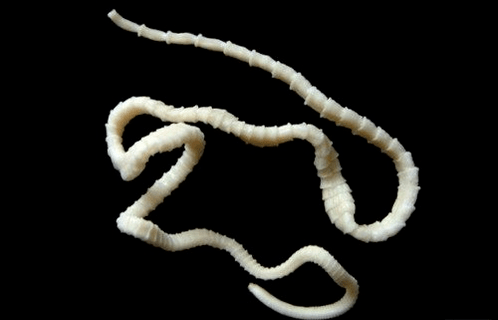
An adult worm reaches several meters in length. The individual takes all the nutrients from the human body and causes severe poisoning.
Symptoms of the invasion include:
- diarrhea and abdominal pain;
- vomiting and nausea;
- restless sleep;
- dizziness and fainting.
The risk of teniarinhosis is when you eat improperly processed beef contaminated with larvae of bovine tapeworms.
Wide ribbon
The cause of difylobotriasis is the consumption of poorly processed fish products and caviar.
The worm that causes the disease is one of the largest and can reach up to ten meters.
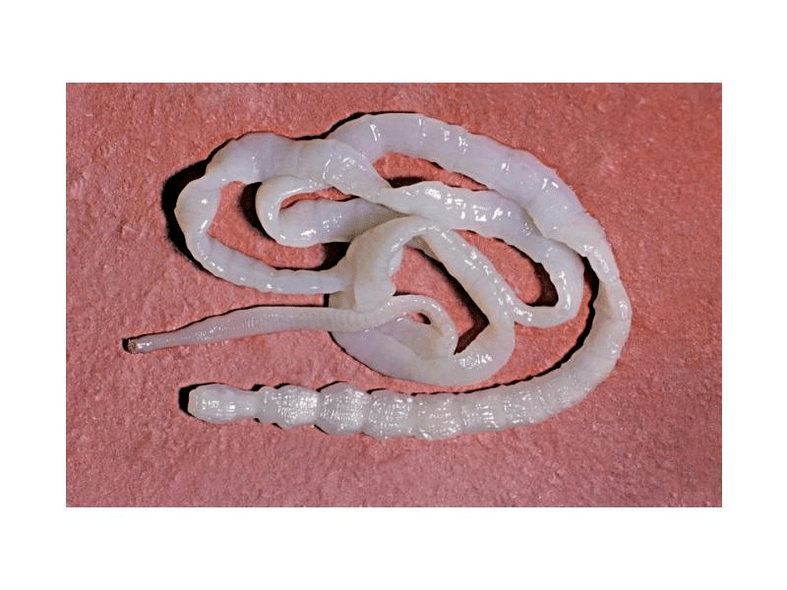
Symptoms of infection include severe abdominal pain and anemia.
Pig tapeworm
Infection with these types of helminths is extremely dangerous to humans. Consumption of improperly cooked pork can cause Finns to enter the body and become adults.
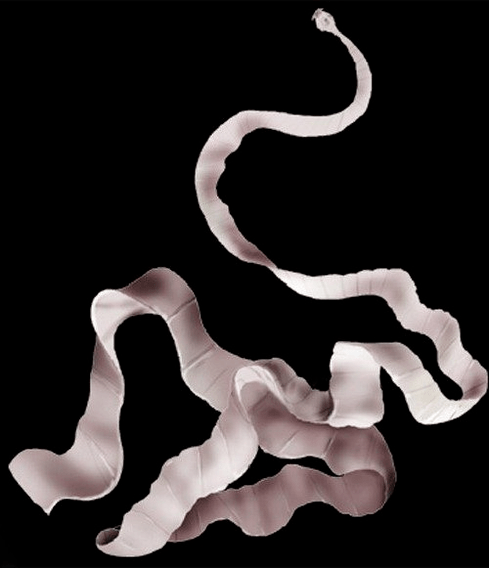
The so-called segments are periodically separated from the body of the porcine tapeworm, which are able to enter the environment through the anus or by leaving feces on their own. Signs of teniasis are similar to bovine tapeworm infection.
Cysticerki
It is a tissue worm that is the product of a porcine tapeworm segment. Segments containing tapeworm eggs enter the external environment and can re-enter the body through external environmental objects and provoke the development of cysticercosis.
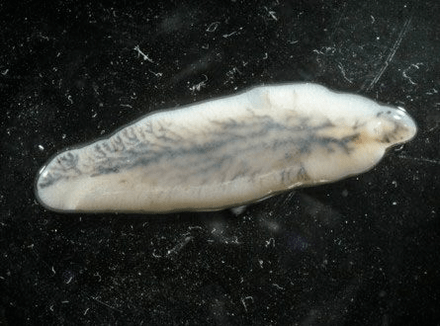
Parasites are located in the muscles, heart muscle, and even the brain.
Important! They have a tightening effect on the organs and cause inflammation.
Liver layer
Opisthorchiasis occurs as a result of the introduction of hepatic fluff larvae and infected fish into the human body.

Signs of the presence of opisthorchiasis:
- nausea;
- diarrhea;
- pains all over the body;
- occurrence of allergy.
More severe symptoms are chronic. This type of parasite is dangerous for the development of liver cancer.
Echinococcus
The worm settles in the body, most commonly in the liver or lungs. Echinococcus can cause the formation of cysts in the affected organ and the appearance of tumors. The infection can be fatal.
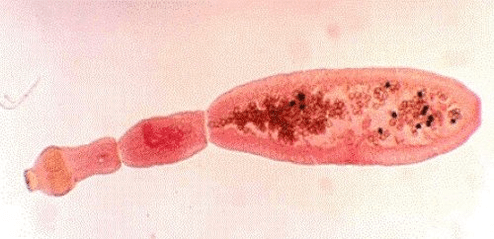
The larvae are transmitted by humans through contact with diseased animals.
Trichinella
Trichinosis mainly affects people who consume poorly processed wild meats. Pigs can also be carriers of Trichinella.
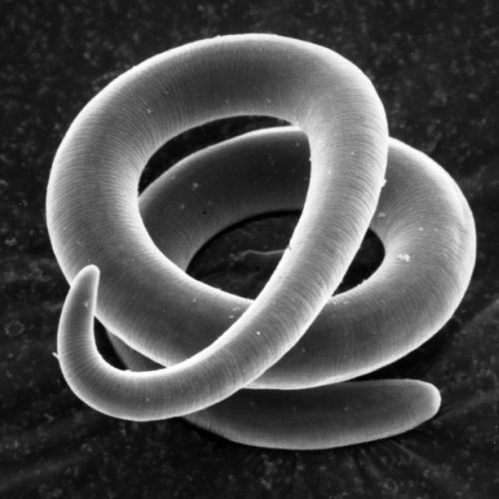
The habitats of adults in the human body are different types of muscles (respiratory, facial, etc. ).
In the early stages, nausea and loose stools occur. Subsequent symptoms of invasion: fever, edema, skin rash, muscle pain. Infection with these types of parasites can be fatal without timely treatment.

Methods of infection with human helminths
- Biohelminthiasis (infection of animals).
- Infectious helminthiasis (spread from person to person).
- Geohelminthiasis (diseases caused by parasites that carry out one of their life cycles on earth).
Factors influencing the manifestations of helminthiasis
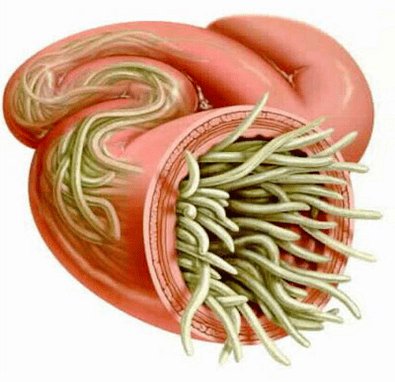
The way the parasite enters the body;
- The degree of adaptation of the helminth to the human body;
- Population density of parasite individuals (number);
- The habitat of the worm (tissue parasites live in the thickness of soft tissues and luminescent ones live in gaps in hollow organs). Some helminths with different phases have both luminal and tissue forms. The larval and developing stages of worms usually cause more pronounced pathological changes.
In the absence of re-infection, the number of adult parasites does not increase in the human body. This property significantly distinguishes helminthic invasions from diseases caused by bacteria, viruses, fungi, and protozoa.
Worms in humans: symptoms
Helminthiasis is a disease characterized by 2 stages of the course (acute, from two weeks to two months) and chronic (from several months to several years).
Symptoms of the acute phase of helminthiasis
The first signs of the disease can occur at different times (most often after 2-3 weeks, in case of ascariasis - after 2-3 days, and in case of filariasis the incubation period can last from 6 to 18 months).
The most common symptom in the acute stage of parasite invasion is an allergic reaction (antibodies are formed against antigens from migratory parasite larvae). People infected with worms often have itchy rashes on the skin, are prone to recurrence, regional lymph node enlargement, generalized or local edema, and muscle and joint pain. Migratory parasitic larvae can also cause chest pain, coughing, suffocation attacks, stool disorders, nausea, and vomiting.
Signs of chronic helminthiasis
The symptoms of the chronic phase depend directly on which organ the parasites "live in" and their size and number also play an important role.
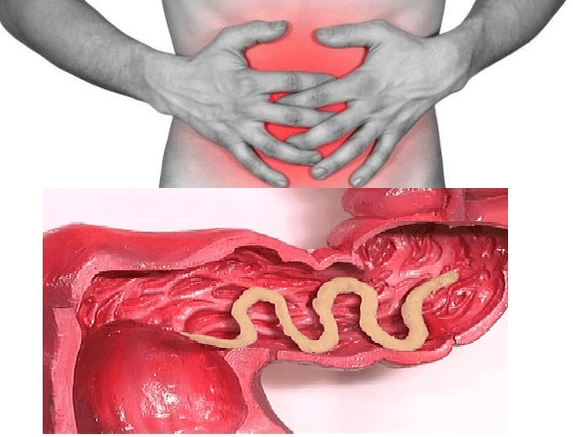
Thus, by parasitizing the intestines of individuals, the disease may be asymptomatic (except in the case of infection with very large parasites). Dyspeptic disorders are characteristic signs of the chronic phase of intestinal helminthiasis. Asthenoneurotic and pain syndromes are more pronounced in children. With massive invasion of roundworms, intestinal obstruction, obstructive jaundice, and inflammation of the pancreas are possible.
Patients with helminthiasis have a significantly increased risk of malignancies due to a weakened immune system and an increased process of cell division (as a result of the constant repair of tissues damaged by parasites).
Types of helminths parasitizing the human body
The pathogens of human helminthiasis are 2 types of worms: round (nematodes) and flat (ribbon and fluc).
Round worms
Pinworm
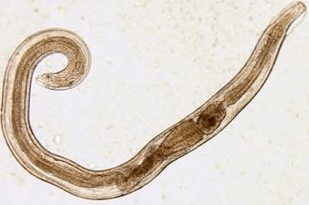
The parasites that cause enterobiasis are small (up to 10 mm) thin hollow worms with an off-white color. The infection is caused by food (through the mouth). This is due to dirty hands. The parasite’s eggs are found in the ground, on the wool of infected animals, unwashed vegetables and fruits, and so on. However, in the case of enterobiasis, self-infection is common (especially in children) as a result of scratching. ingestion of itchy areas and subsequent eggs. The pinworm larva develops in the digestive system within two weeks. As adults, the worm parasites the lower and upper sections of the colon.
Ascaris
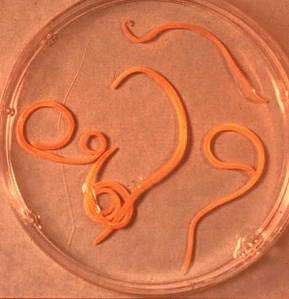
Ascaris is a large spindle-shaped parasite, red-yellow in color, reaching 40 cm (females) and 15-25 cm (males) in adulthood. Without suction cups or other fastening devices, the globular worm is able to move independently towards food masses. The eggs laid by the female of the parasite are excreted along with the feces.
Vlasoglav
Vlasoglav, the causative agent of trichocephalosis, is a white helminth 4-5 cm in size parasitizing in the early stages of the colon. The parasite feeds on the blood and tissues of the rectal mucosa.
In a small number of worms, trichocephalosis is asymptomatic. In the severe stage (with massive invasion), the patient causes abdominal pain, severe diarrhea, sometimes accompanied by rectal prolapse. This condition is most common in debilitated children. In the middle phase of trichocephalosis, growth retardation of the child is possible.
Trichinella
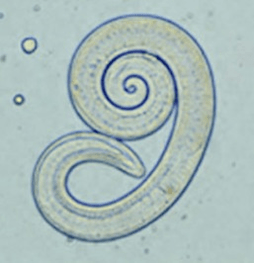
The causative agent of trichinosis is a small round helminth 2-5 mm long. Infection occurs with the consumption of poorly roasted meat (pork, bear meat, wild boar). Penetrating into the intestines, the parasite larvae reach the state of a mature individual in 3-4 days. The worm has a lifespan of 40 days, after which the parasite dies. By piercing the intestinal wall, the larvae enter the bloodstream and reach all the organs of the human body, settling in the muscles. In this case, it most often affects the respiratory and facial muscles as well as the flexor muscles of the limbs.
In the first days after invasion, patients complain of abdominal pain. After about 2 weeks, the body temperature rises to 39-40 C, itchy rashes appear on the skin, muscle aches develop and the face swells. During this period, there is a significant risk of death in the event of a massive infection. After about a month, the patient recovers. The parasite is sealed in a spiral and then dies within two years.
Hookworm and nekator
These two parasites are similar in their biological properties as well as in the diseases they cause. In this respect, they are usually combined under a common name (hookworms). Worms 10-15 mm long parasitize in 12-p. gut. It should be noted that this is one of the most common, but at the same time quite rare parasites. The larvae of the worms enter the human body through the skin in contact with the contaminated soil. Furthermore, once in the bloodstream, they migrate to the lungs like globular worms and then through the bronchi to the digestive system along with the expectorant sputum. An ankylostoma parasites the intestine, attaching to the intestinal wall. Therefore, the most characteristic symptoms of this helminthiasis are iron deficiency anemia and changes in the proportion of protein fractions (dysproteinemia).
Flat worms
Wide ribbon
It is one of the largest helminths with a length of 10-20 meters. The disease caused by this parasite is called diphyllobothriasis. The developmental cycle of the worm begins with freshwater fish or crustaceans. The larva, along with eggs or infected fish fillets, enters the human body, which is the ultimate owner of the broad tapeworm. Once in the small intestine, the parasite clings to its wall and grows into a mature individual within 20-25 days.
Diphyllotriasis occurs in the background of gastrointestinal disorders and B12-deficient anemia.
Liver layer
The parasite that causes opisthorchiasis is a flat worm with a length of 7-20 mm. Human infection occurs when contaminated fish meat is consumed that has not undergone sufficient heat treatment. The larva of the liver beetle from the small intestine penetrates the bile duct and the gallbladder, where it is fixed by means of two suction cups.
In the acute phase of helminthiasis, the patient has abdominal pain, fever, nausea, muscle pain, diarrhea and rash are possible. Chronic course of opisthorchiasis is associated with symptoms of hepatitis, bile duct inflammation, gallbladder inflammation, gastrointestinal disorders, nervous disorders, weakness, and increased fatigue. The parasite leads to irreversible changes, and even after expulsion, the patient does not undergo chronic inflammatory processes and functional disorders.
Bovine and porcine tapeworm
These parasites, which have almost the same structure, reach a length of 5-6 meters. Infection with teniarinhosis and teniasis occurs due to the consumption of beef or pork meat infected by Finns (an intermediate form of helminthiasis). Viable Finns attach themselves to the wall of the human small intestine in the form of 0. 5 cm whitish bubbles and become adults within 3 months. The strip parasite of more than 2, 000 segments is constantly growing.
Echinococcus
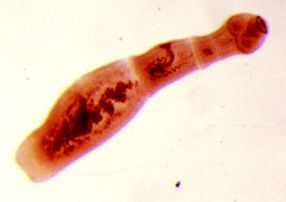
A person is an intermediate host for this parasite. The worm parasitizes the human body in the form of Finns. The ultimate owner of an echinococcus is a wolf, dog, or cat. Infection occurs with food, coming into contact with animals and environmental objects inoculated with Echinococcus eggs. Once in the intestines, oncospheres (six-hooked larvae) develop from them. They enter the bloodstream from the intestines and can be carried throughout the body.
Alveococcus
This parasite, considered the type of echinococcus, causes one of the most dangerous helminthiases (alveococcosis), which is similar in severity to cirrhosis and liver cancer. Infection occurs when oncospheres (eggs with mature larvae) enter the intestines. Laurocysts are very aggressive formations that grow continuously due to growing bubbles and are also able to grow into the liver as metastases from cancer. Necrotic changes due to vascular dysfunction go through necrotic changes in nearby tissues. Spreading to nearby structures, the alveococcus forms fibrous nodules with inclusions of multi-chamber bubbles. This condition can last for several years and therefore requires mandatory surgery.
Diagnosis of helminthiasis
Diagnosis of helminthic invasions includes the following activities:
- careful collection of the anamnesis to help understand the possible causes of the infection;
- laboratory examination of faeces, blood, 12p intestinal contents, rectal and perianal mucus, muscle tissue, lung sputum, bile. The analysis may reveal eggs, segments or fragments of the parasites. However, increased eosinophil levels in the blood also indicate the presence of helminthiasis.
- when diagnosing diseases caused by larval stages or tissue parasites, serological tests are performed (ELISA, RSK, indirect agglutination reaction, immunofluorescence analysis, etc. ).
- ultrasound, CT, and endoscopic examinations are prescribed to identify worms that affect liver tissue.
Worms in humans: treatment
In the acute phase of the parasitic infection, the patient is prescribed detoxification and desensitization therapy. In severe cases of the disease (liver trematodes, trichinosis) glucocorticoids are used according to medical indications.
Special anthelmintic chemotherapeutic agents are prescribed as a specific therapy drug, taking into account the nature of the pathogen.
In parallel, the patient is recommended to take antihistamines and enterosorbents. The final stage of treatment involves the use of probiotics that normalize the intestinal microflora.
A special gentle diet is also prescribed (the food must be digestible and low in fat).
During anthelmintic therapy, the patient should adhere to strict personal hygiene (to avoid re-infection). However, for many helminthiasis, all family members and individuals who are in constant contact with those infected should be treated.
The underestimation of their danger, along with the lack of knowledge about the biology of these creatures and how to infect them, has led to at least a few billion people carrying certain parasites.
Parasites can be present not only inside the human body, but even outside the human body.
Prevention of parasitic infections
Rule 1:it must not be eaten from fish which is not sufficiently salted, fried or cooked. Sushi, lightly salted herring or sashimi can be considered a gourmet dish. But it is essentially raw fish, and fish is a component of the life cycle of parasitic worms.
How it all happens:first the larva enters the mollusk, where it does not grow more than a certain limit, then the fish eats the mollusk, the larva enters the digestive system, survives, and then grows and reproduces, entering the muscle tissue of the fish, then this fish is dolphin, seagull or polar beareat it. Or a restaurant visitor who chooses to join the high Japanese culture.
Safe raw fish theoretically exists. To do this, they must either be frozen immediately after catching and thawed immediately before cooking, or they must be grown specifically in a fish farm to prevent the absence of parasites. But it is usually impossible to verify that it has actually been made into a risky food.
The same care should be taken with meat, don’t try raw minced meat and freshly salted bacon.
In addition, in order to avoid being infected with helminths, vegetables and hands should be washed before meals. As part of the natural environment, it can be stated that these parasites are almost ubiquitous in the human body.
Any contact with food or hands with soil, dirt, and vegetation can leave their microscopic eggs on the food. When they enter the intestines, worms hatch from the eggs, which will not be easy to remove.
There are parasites that attack a person walking or resting in nature, such as:
- malaria plasmodium, found in the saliva of mosquitoes of the genus Anopheles,
- the causative agent of encephalitis in the saliva of ixodide ticks,
- gadfly and wolfarth fly.
Their prevention is the use of all kinds of alarm devices in wild hiking, as well as the maximum protection of open areas of the body (mosquito nets, nets, special gel).
But what can you do if prevention hasn’t helped? Because the attack has long been known, treatment by folk methods has also been known for a long time.
In conclusion, adherence to simple hygiene and hygiene rules, and the eradication of flies and cockroaches can significantly reduce the risk of infection with parasites, which can lead to serious consequences.
























